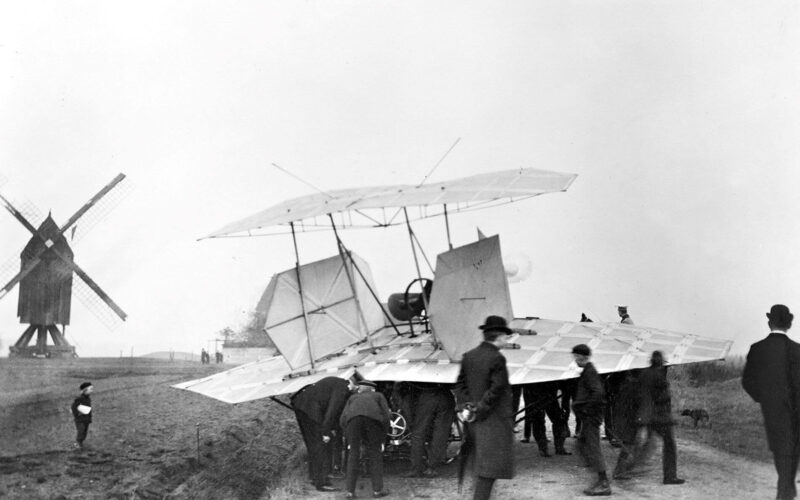While it is hard to dispute the fact that the Wright Flyer was, technically, the first controlled airplane to fly under its own power, there is no denying that it was preceded by other attempts and followed by other claims. Some of those attempts and claims were rather impressive indeed, and today we are going to rank them!
The ranking is simple: the more realistic, the more functional the airplane appears, the higher score it gets. There is no denying that some of them could, theoretically, have conducted the first powered flight, if the circumstances have fallen in their favor. They did not, but it does not mean that those airplanes are not worthy of attention and respect.
10. Langley Aerodrome

Langley Aerodrome about to smack into the water (Photo: Wikipedia)
In Greek “Aerodrome” means “Air runner” and Samuel Langley used his word to describe his attempts at light powered manned and unmanned airplanes. Unmanned ones flew rather well (meaning, they stayed in the air for up to a minute or so), but the manned one had problems with controls and crashed into the river twice, right after being launched by a catapult. The second crash happened on December 8, 1903, just nine days before Wright brothers successfully took off with their Flyer.
9. Ezekiel Airship

A replica of Ezekiel Airship (Photo: Michael Barera / Wikipedia)
One of the most unique and the most striking visually, this attempt at an airplane featured paddle wheels instead of propeller and Bible-inspired name. Built by Texan priest Burrell Cannon, it allegedly flew in 1901, but there is little evidence that it actually happened or that the aircraft was capable of flight. Still, we have to give the father props for effort.
8. Hiram Maxim’s flying machine

A sketch of the railborne machine (Photo: Wikipedia)
Sir Hiram Stevens Maxim – yes, the same one who invented machinegun – experimented with various designs of flying vehicles through the late 19th century. One of them was actually capable of flight and demonstrated that during trials in 1894. It was tethered, ran on tracks, and briefly hopped into the air several times, although those hops were anything but controlled. Maxim abandoned the work some time after, saying that without much more powerful engines any such attempts were pointless.
7. Kress Drachenflieger

A dragonflier which did not fly, but at least looked the part (Photo: Wikipedia)
It was the first attempt at a floatplane, constructed in Austro-Hungarian Empire in 1901. While the aircraft took taxiing trials like a champ, the take-off proved to be quite a challenge as its engine was not powerful enough. Better engine could have saved it, but the same could be said about almost every single entry of this list.
6. Ader Avion III

A replica of Avion III. No, it was not constructed as a prop for some Myazaki-inspired cosplayer (Photo: Roby / Wikipedia)
Possibly the most steampunk aircraft ever constructed, Ader Avion III is a brainchild of French engineer Clément Ader. Two projects had preceded it – Avion II, which was never completed, and Éole, which has a serious claim to be considered the first powered unmanned aerial vehicle. Avion III, finished in 1987, was not able to lift itself into the air with its own engines, despite Ader later claiming otherwise. Nevertheless, it looked really impressive.
5. Du Temple Monoplane

A very rough sketch (Photo: Félix du Temple / Wikipedia)
The monoplane, constructed by French officer Félix du Temple in 1874, quite definitely was the first powered aircraft to fly. Well, it did not really fly as much as hopped briefly into the air, and the flight was powered not as much by a vastly underpowered steam engine as by a freefall from a ramp, but it was the first nonetheless.
4. Mozhaysky’s airplane

A less rough sketch (Photo: Wikipedia)
This contraption, very similar to Du Temple Monoplane in concept, was constructed by Russian naval officer Alexander Mozhaisky in 1884. It achieved slightly more: flew for a couple of dozens of meters after being launched from a ramp, before smashing into the ground. It was not capable of taking off under its own power and would be uncontrollable in a normal flight, but still looked rather neat with its huge boxy wings.
3. Richard Pearse monoplane

Less of a replica, more of an approximate reproduction of the monoplane (Photo: Karora / Wikipedia)
A farmer from New Zealand, Pearse patented his flying machine in 1906. But witnesses say that the work, and possibly testing, began before 1903. It is very unlikely the monoplane flew so early, but it did not stop some New Zelanders from claiming that Pearse first flew in 1901. His designs were really capable of flying, it is just that they, most likely, were completed a bit too late to be considered first.
2. Jatho biplane and triplane

German engineer Carl Jatho completed several short, uncontrolled flights with his planes between August and November 1903. Although later some people tried to claim they were controlled, there is not much ground behind the claim. Nevertheless, Jatho flew. Although he himself considered his airplane attempts a dead end, they could lift the engineer into the air for at least several seconds.
1. Gustave Whitehead airplane

Whitehead and his lads with the supposedly flight-capable monoplane in 1901 (Photo: Valerian Gribayedoff / Wikipedia)
One of the most serious and widely acclaimed contestants to the Wright brothers, Gustave Whitehead supposedly made the first flight on his monoplane in April or May 1899. He crashed into a wall, had trouble with police, and therefore – again, supposedly – could not publish his claim. There are a lot of discrepancies in this story and it was thoroughly debunked, but the designs on which Whitehead worked before 1903, but definitively tested just several years later, were really capable of powered flight.

